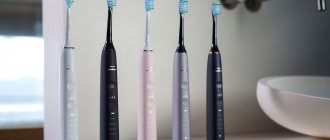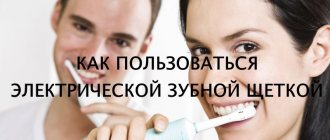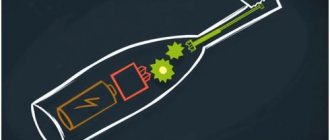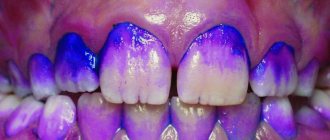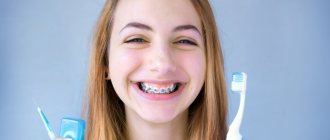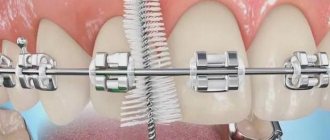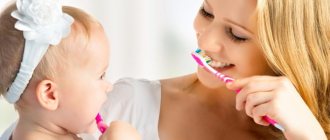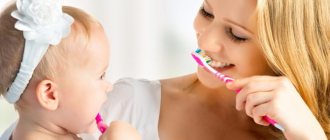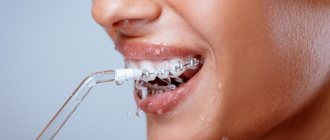Daily oral hygiene is a routine process, brought to the point of “automation”. Often we brush our teeth without thinking about the rules, the position of the brush and the direction of movement. Meanwhile, not only the aesthetic appeal of a smile, but also its health depends on how well oral hygiene is performed. Many dental problems can be avoided (prevented or eliminated) only by following the basic rules of effective teeth brushing.
Consequences of improper teeth brushing
It may surprise some, but improper brushing not only does not get rid of plaque, but can also lead to deterioration of the condition of teeth and gums. Surprising, but nevertheless, it is a fact.
The most common mistake when using a classic (manual) brush is brushing your teeth only with horizontal movements (right - left). With this method:
- the interdental spaces are not cleaned, becoming additionally clogged with plaque;
- Plaque near the gums is not removed, forming large accumulations of dirt and pathogenic microflora.
The above leads to problems such as:
- wedge-shaped defect (in its advanced form it can cause exposure of the neck and fracture of the dental crown);
- caries;
- periodontitis (inflammation of the tissues surrounding the teeth);
- inflammatory processes, bleeding gums;
- formation of tartar;
- pronounced darkening of the enamel;
- bad breath, etc.
Even when using high-quality toothpastes and brushes, the best preventative measure for the mentioned dental problems is still choosing and following the correct teeth brushing technique.
Choosing a toothpaste
The paste should also be used taking into account the oral condition of each person.
One has sensitive teeth - a special toothpaste is needed to reduce sensitivity. Another has such microflora in his mouth that plaque builds up very quickly - he needs an antibacterial one. In the third case, there may be bleeding gums - a paste is needed for gum health. Very often all this can be combined, then a combined action paste is needed. When choosing a paste manufacturer, you must also focus on your feelings. After all, it is very important that brushing your teeth is comfortable, and if the taste of the toothpaste causes nausea, a person is unlikely to benefit from it. It happens that, apparently due to the individual characteristics of the oral microflora, after brushing your teeth with certain pastes, after some time a film forms on the oral mucosa, which creates discomfort. In this case, it is better to replace the paste.
Many people want to make their teeth lighter and for this they constantly use whitening toothpastes. Here you need to know that modern whitening pastes most often contain enzymes that facilitate easier removal of plaque. Although these pastes do not harm the enamel, they can only be used daily for 1-2 months. Highly abrasive whitening toothpastes (used mainly for smokers) are more effective, but also dangerous to the enamel. They can only be used 1-2 times a week.
Classical technique of brushing teeth (Pakhomov G.N. method)
Most Russian dentists recommend the method of brushing teeth, invented by professor of dentistry Gennady Nikolaevich Pakhomov.
Pakhomov's method G.N. is considered the most effective and consists of the following algorithm of actions:
- The dentition should be divided into 4 segments (left and right parts of the upper jaw, left and right parts of the lower jaw).
- It is advisable to start cleaning from the upper jaw from the right molars towards the front teeth. Next, brushing along the top row continues from the front teeth and ends on the left molars.
- The lower jaw is cleaned, on the contrary, from the left molars to the front ones and ends at the right molars.
- When cleaning the outer and inner surfaces of the dentition, the brush must be held horizontally. The bristles should be positioned at a 45° angle to the surface of the teeth and gums. Cleaning is carried out with sweeping movements from the gums to the edge of the tooth. For each pair of teeth, 10 such movements must be performed.
- Contaminants from the chewing side of the teeth are removed by moving the brush head back and forth (reciprocating movements). At the same time, the fibers of the brush penetrate deeply into the interdental spaces and fissures, providing high-quality cleansing.
- To clean the inner surface of the front teeth, it is more convenient to place the brush vertically. Cleaning is also carried out using sweeping movements from the gums to the edge of the tooth.
Standard method of Pokhomov G.N. allows you to thoroughly clean the oral cavity. If there are hard-to-reach areas of the dentition that are inaccessible to the toothbrush used, then it is recommended to use additional means - dental floss, irrigators, etc.
Important to remember!
- The tooth has five surfaces, and the brush processes only three of them. Therefore, in addition to a toothbrush, it is necessary to use interdental floss and interdental brushes daily to clean the lateral surfaces of the teeth.
- Don't forget to brush your tongue. To do this, you can use the back of a brush or a special scraper.
- Remember! Regular and thorough dental care is an important part of caring for the health of the whole body.
Take care of your teeth and smile!
Additional methods of brushing teeth with a manual brush
The following two assistive techniques for brushing teeth are the most common:
Bass method
The peculiarity of this method is that it is suitable for cleaning teeth with open (exposed) root areas. The method provides not only cleaning of the teeth, but also massage of the gums.
The implementation of this technique provides for the following rules:
- The toothbrush must be held horizontally, at an angle of 45° to the surface of the tooth. In this case, half of the fibers of the toothbrush should extend beyond the gums.
- Cleaning is carried out first in a circular motion, then sweeping (from the gum to the edge of the tooth).
- To clean the internal surfaces and back (molars) teeth, the position of the brush changes to vertical.
- Cleaning the oral (palatal) and vestibular (external, from the lips and cheeks) surfaces of the tooth is performed with vibrating movements without moving the ends of the bristles.
- Chewing surfaces are cleaned with horizontal back-and-forth movements.
It is important to note that you should only use a soft toothbrush for this method.
How to choose a toothbrush
Your dentist's advice will be of great help in choosing a toothbrush.
A soft brush may not clean your teeth as effectively, and hard bristles can damage your enamel and gums. Most often, a medium-hard brush is used. Many people are interested in what is better - an electric brush or an ordinary one. Dentists recommend brushing your teeth with an electric brush no more than 2-3 times a week, because... otherwise the enamel may be damaged. Good reviews about ultrasonic brushes. They allow you to remove plaque in hard-to-reach places due to ultrasonic vibrations that lift plaque from the surface. Recommended for sensitive teeth, braces, periodontal diseases, and other situations where mechanical cleaning is difficult. However, the peculiarities of such brushes are their rather high cost, as well as the presence of contraindications - for cancer patients, people with cardiovascular diseases, mental illnesses, pacemakers and children under 9 years old.
A FEW SECRETS OF SUCCESS
To make the process of teaching your child personal hygiene easy and painless, you should consider some simple but important recommendations.
- It is better to choose the first brush with your baby, he should like it.
- Diversity is also welcome! You can purchase several brushes so that your baby has a choice every day. This will help keep his interest.
- Maintain consistency. It should be clearly understood in the child’s mind that brushing teeth is a mandatory procedure that must be performed twice a day. Encouragement in the form of permission not to brush your teeth is unacceptable.
Praise must be present. You can use the oral form, or you can turn to visualization, for example, post a poster on which each successful brushing of teeth is marked with an asterisk, sticker or picture. The kid will try to replenish the “collection” and will show due diligence.
Experts advise against using material rewards, such as candy, for efforts. The child must understand from the very beginning that brushing his teeth is a mandatory hygienic procedure that he must perform for the sake of his own health. No one will give gifts for this.
In any case, you cannot force your child to brush his teeth; it is necessary to show attention, care and tact, to turn every visit to the bathroom into a fun game, only in this case the process will become as productive as possible. The sooner you start working on oral hygiene, the fewer possible problems you will have to deal with later.
What to choose – toothpaste or tooth powder?
The correct answer is toothpaste .
Despite the fact that the powder can even clean teeth more effectively in some cases, its use has been proven to be unsafe for enamel. The same can be said about whitening toothpastes that contain abrasive particles. They can be used from time to time (according to dentists - no more than once a week), but for constant use it is better to choose a softer option. In general, the choice of toothpaste depends on your taste preferences, as well as the final result you get after brushing. In general, a toothbrush and toothpaste should be sufficient, however, dentists also recommend additional use of dental floss. The fact is that there are surfaces of teeth that are quite difficult to clean with a regular brush. However, much depends on the structure of the oral cavity - for some, the distance between the teeth is quite large, so floss is not needed, but for others, on the contrary, it is too small, and the floss can damage the gums. Subsequently, such an injury can lead to periodontitis - therefore, the use of dental floss should still be based on the individual characteristics of the person. Sources:
- https://MikDent.ru/estetika/uhod/kak-pravilno-chistit.html
- https://doctorslon.ru/company/articles/kak-pravilno-chistit-zuby-tekhnika-chistki-manualnoy-i-elektricheskoy-shchyetkoy/
- https://azbyka.ru/zdorovie/kak-pravilno-chistit-zuby
- https://www.StartSmile.ru/gigiena-polosti-rta/kak-pravilno-chistit-zuby.html
- https://DrZubastik.ru/chistka-zubov/pravila-i-tekhnika.html
- https://dentalgu.ru/statyi/other/chistka-zubov/
Professional cleaning
Professional hygiene is performed by a doctor in a clinical setting. Advantages of the procedure:
- Effective removal of contaminants - plaque and stone.
- Using ultrasound, stone is removed from the sub- and supragingival spaces.
- Cleaning gum pockets.
- Polishing the enamel with a special paste.
- The enamel is also coated with varnish, a fluoridating compound that nourishes the dental tissue. This is required to prevent oral pathologies.
- After the procedure, the enamel becomes lighter.
In addition to ultrasound, Air-flow devices are used for professional cleaning, the action of which is based on the action of soda, water and air. A high-pressure jet from the device cleans teeth, but this method is suitable for soft stains.
Professional cleaning is suitable for persons over 16 years of age. Contraindications include arrhythmias, tuberculosis, hepatitis, HIV, ARVI.
ABOUT THE IMPORTANCE OF THE PROCEDURE
Some parents mistakenly believe that caring for baby teeth is a waste of time, because over time they will be completely replaced by molars. Dentists assure that this is not so: tooth enamel is very thin in any case, the sugar contained in food can damage it, which, in turn, will cause infection, including sore throat and pyelonephritis.
In addition, a diseased tooth does not take part in the process of chewing food, which will negatively affect its digestion. If caries is advanced, there is a risk of tooth extraction, which will negatively affect the bite, and can also cause curvature of permanent teeth and the occurrence of defects in the pronunciation of certain sounds. That is why competent and timely care is necessary.
OPTIMAL AGE
Oral care should begin even before the first baby tooth appears, since during feeding, microorganisms that cause candidiasis and stomatitis enter the mucous membrane. Therefore, it is best to carry out the first “cleaning” at 2-3 months. This early care will include cleaning the gums and uvula with a gauze pad or a special dental fingertip.
When the baby is 6 months old, his ejection reflex becomes weaker, so other devices can be used:
- finger brushes;
- children's toothbrushes with soft bristles.
The first lessons on self-cleaning can be held a year, and the baby should fully master this process by 2 years. From 2-3 years old, it is permissible to use a special children's toothpaste that is safe in case of accidental ingestion, preferably without fluoride. Starting from the age of three, you can offer your baby an electric brush. But if a child experiences fear from vibration, then the new product should be abandoned in favor of the classic model.
